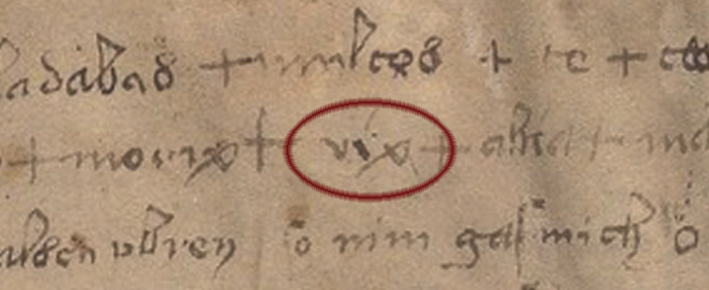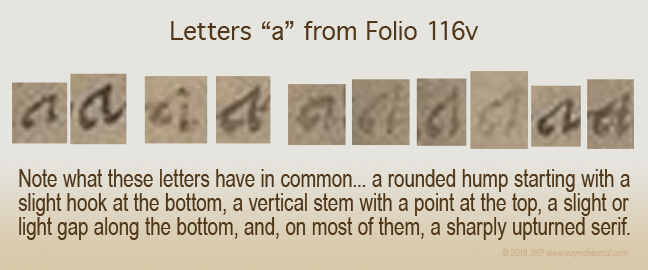I often wonder if the text on VMS f116v was a later addition to the manuscript, and whether the writer had any knowledge of Voynichese. The Voynichese characters in the lower left are often mentioned but I’ve never seen an assessment of the folio overall. Are there clues that have been overlooked?
 Researchers mostly agree that “aror sheey” in the lower left is Voynichese, even if they don’t agree on whether the first glyph is “a” or “o”. There are quite a few ambiguous “a” or “o” glyphs in the VMS, so some transcripts include both possibilities.
Researchers mostly agree that “aror sheey” in the lower left is Voynichese, even if they don’t agree on whether the first glyph is “a” or “o”. There are quite a few ambiguous “a” or “o” glyphs in the VMS, so some transcripts include both possibilities.
However, just because the Voynichese lines up with the other text on the line, I didn’t want to assume there was a connection between the Voynich characters and the 116v text. The ink that follows “aror sheey” is darker, and the letters are Latin, with different thick-and-thin proportions. It isn’t necessarily written by the same person. The drawings and Voynich glyphs might have preceded the other text by days or years.
But is this the only Voynichese on the folio?
In a past blog, I’ve mentioned that the “i” shape in “vix” looks like Voynichese. It’s darker, is distinctively backleaning, and doesn’t resemble any of the other “i” letters on the folio:
I am not sure if the word after oladabas is multos, imiltos, or something else, so I did not include the debatable “i” in this word. I’m also uncertain about letters 2 and 3 in abia/ahia/alka, so I didn’t include this either. All the other “i” letters are fairly consistently upright, with distinctive serifs, as can be seen from the samples. They do not resemble the “i” shape in “vix”:
 Okay, so maybe there is another Voynichese character besides “aror sheey”, but why just one in the middle of a line? When there is only one, it’s hard to speculate on the reason. Was the writer a VMS scribe who slipped into an old habit? Or is it purely coincidence?
Okay, so maybe there is another Voynichese character besides “aror sheey”, but why just one in the middle of a line? When there is only one, it’s hard to speculate on the reason. Was the writer a VMS scribe who slipped into an old habit? Or is it purely coincidence?
Here comes the interesting part, something I haven’t seen mentioned… might there be another Voynichese glyph? One that’s completely overlooked?
Look at these “a” letters. Even though the handwriting is variable, they do have some important commonalities:
The most distinctive traits of these letters are the upright pointed stems, and the distinctively upturned serifs. I’ve tried for years to find handwriting that matches this “a” shape and it’s quite difficult.
Now look at the second “a” in this clip, from one of the most scrutinized words on the folio:
With the angled stem and lack of a serif, this character resembles the Voynichese “a” more closely than the other “a” glyphs on this folio. But is it Voynichese? The shape is right, but the stem stretches slightly farther below the baseline than most Voynich “a” glyphs.
If it is a VMS “a” then it might be important. For example, perhaps
- whoever wrote the 116v text knew Voynichese and used it occasionally (maybe for pronunciation purposes? or to represent a letter that doesn’t exist in Latin?), or
- whoever wrote the 116v text was at least familiar with Voynichese glyphs, even if he or she didn’t know the meaning of them, and wasn’t necessarily using the last page as a place to write something completely unrelated to the rest of the manuscript, or
- whoever wrote the 116v text helped pen the Voynichese text and would sometimes slip into the habit of using the often-repeated glyph forms.
After 10 years of sampling medieval text that resembles the letterforms on f116v, it seems probable that it was written in a late-14th or 15th-century script, so the writer could have been contemporary with the creators of the VMS. If the “a” in oladabas is Voynichese, then it increases the likelihood that the writer was aware of the VMS shapes in a more than casual way and maybe even helped design or pen other parts of the VMS.
J.K. Petersen
© Copyright 2018 JK. Petersen, All Rights Reserved



